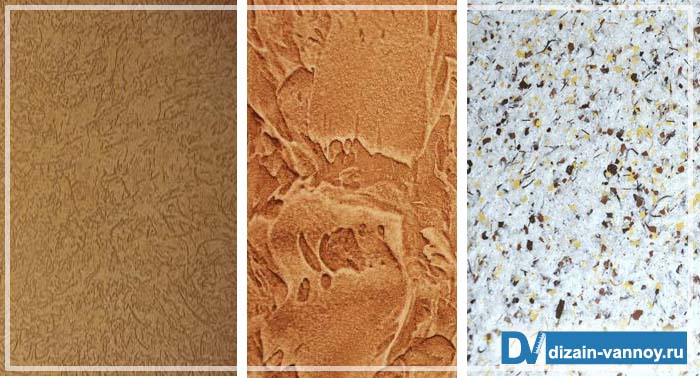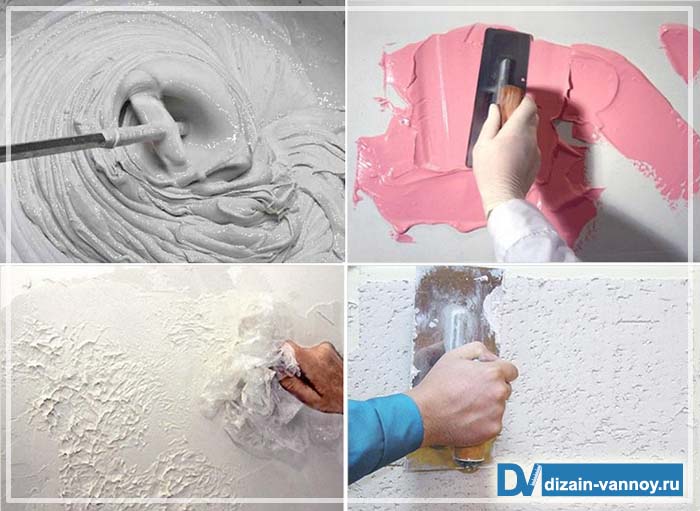Decorative plaster in the bathroom. Types and characteristics of materials
Each owner of a bathroom has the right to independently choose options for finishing the room using a huge range of different materials on the modern construction market. In most cases, ceramic tiles are traditionally chosen as the main material, but recently decorative plaster has been increasingly used in the bathroom. In this article, we will consider what advantages this material has and give a few photos that demonstrate the result of its application.
Decorative textured plaster in the bathroom has been used relatively recently, since earlier it was widely used only for finishing the exterior facades of a building or in interior rooms, such as a living room, kitchen or bedroom. At the time of its appearance, this type of decoration was used only for decorating service or technical premises. As positive reviews regarding its use filled the information space, this type of plaster gradually mastered new types of premises and acquired additional technical characteristics through the use of organic or synthetic additives.
Positive characteristics of decorative plaster
Decorative plaster in the bathroom is laid in the same way as on any other surface area, since it is not exposed to moisture and retains its physical characteristics. The advantages of this type of material include such features as:
- presentable appearance;
- a large number of color solutions and texture options;
- ease of maintenance and restoration in case of accidental mechanical damage;
- high rates of vapor permeability, which allow the walls to breathe and prevent the formation of condensate on the surface.
The properties of plaster allow you to apply any pattern on it, paint it in any color and create unique patterns.
Important! Despite the high vapor barrier properties of the material, finishing the bathroom with decorative plaster provides for the installation of high-quality ventilation, which will maintain the required level of humidity and air circulation. Excess moisture can serve as a good breeding ground for mold and fungal bacteria.
The main types of decorative plaster

Of the decorative coatings of this type, the most common are mixtures such as:
- mixture with bark beetle granules;
- Venetian plaster;
- homogeneous rough plaster.
According to the type of texture transmitted, plaster mixtures are divided into three main types:
- furrowed;
- rough homogeneous;
- modeling.
Venetian plaster for the bathroom belongs to the type of modeling, since these types of mixtures allow you to create various patterns or embossed patterns at the discretion of the master or customer. The design using such mixtures looks chic, but such work is very expensive, since Venetian plaster in the bathroom requires the work of a professional master, which is paid accordingly. Homogeneous mixtures with a rough surface are used most often. Their application does not require special skills and a perfectly smooth surface. They have a large number of color options and can also be dyed with special color additives to the taste of the customer. Bark beetle in the bathroom is used less often than others and mainly to cover surfaces remote from the water source.
Advice! Finishing the bathtub with decorative plaster can be done using special stencils with various patterns and patterns. This technique allows you to elegantly decorate the room, using even the simplest mixture.
Rules for surface preparation before applying plaster

Basically, textured bathroom plaster does not require perfectly prepared and smooth surfaces, with the exception of Venetian, which requires a perfectly smooth plane. Otherwise, surface preparation is similar to the technology for preparing walls for laying tiles. The main requirements for the surface can be considered:
- lack of dirt, dust and moisture;
- no oily or rusty spots;
- obligatory application of primer or preliminary plaster.
If you have a perfectly flat concrete wall at your disposal, then decorative plaster in the bathroom is applied without prior leveling, but with the obligatory application of a primer in 2-3 layers, which will ensure better adhesion of the mixture to the wall plane.
Important! If the surface requires preliminary leveling, then preliminary plastering is used, followed by a primer. In such cases, a special sanitizing plaster is used for leveling. This type of plaster is used only for leveling walls and creating a base for decoration. It cannot be used for finishing.
Decorative plaster for bathrooms will last a very long time if you first apply a thin layer of the above sanitizing mixture. This mixture provides additional waterproofing, absorbs excess moisture, regulates the overall humidity in the room and prevents the release of salts. The mixture is environmentally friendly, easy to lay on the surface. Textured plaster for the bathroom can be applied immediately after the primer has dried, as it has good viscosity and does not crack even if it dries unevenly.
Features of working with textured plasters

If you decide that you will have plaster in the bathroom instead of tiles, then when choosing a mixture, you need to consider several important points and characteristics. When buying ready-made liquid solutions, you need to remember that working with them is a little more difficult, since they are already diluted to the desired consistency and cannot be further diluted with water.
The most difficult type of material is plaster with large crumbs of different fractions. Finishing the bathroom with decorative bark beetle plaster should only be carried out by an experienced craftsman. Pay special attention to the composition of the product and its components. Mixtures for interior work should not contain any toxic substances.
Below we attach a video material that will show how to apply decorative plaster on the surface.






